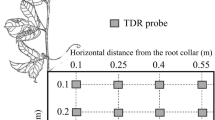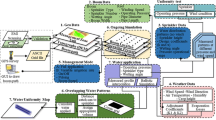Summary
Soils continue to drain for several days following irrigation. Water budgeting predictions can be improved by accounting for this, provided hysteresis is recognized in the “field capacity” condition. Uncertainty in this condition was evident in experiments comparing predicted soil water depletions with neutron probe measurements. Comparisons were made for potato, lettuce and calabrese crops, irrigated by hose-reel machine. Best agreement between measurements and predictions was obtained when excess water storage above a lower field capacity condition was allowed for; corresponding to minimum root mean square errors of 3.2 mm–6.2 mm. These were comparable to the practical limits of uncertainty associated with field depletion measurements.
Similar content being viewed by others
References
Arya LM, Farrell DA, Blake GR (1975) A field study of soil water depletion patterns in presence of growing soybean roots: Determination of hydraulic properties of the soil. Soil Sci Soc Am Proc 39:424
Baier W, Robertson GW (1966) A new versatile soil moisture budget. Can J Plant Sci 46:299
Bell JP (1976) Neutron probe practice. Institute of Hydrology Report No 19. Wallingford
Bibby JS, Douglas HA, Thomasson AJ, Robertson JS (1982) Land capability classification for agriculture. Soil Survey of Scotland, Macaulay Institute, Aberdeen
Brock TD (1981) Calculating solar radiation for ecological studies. Ecol Modelling 14:1
Cassel DK (1974) In-situ unsaturated soil hydraulic conductivity for selected North Dakota soils. Bulletin 494, Agric Exp Stn, North Dakota State University, Fargo
Doorenbos J, Pruitt WO (1977) Crop water requirements. FAO Irrig Drain Paper No 24, Rome
Francis PE, Pigeon JD (1982) A model for estimating soil moisture deficits under cereals in Britain. J Agric Sci 98:651
Gardner CKM, Field M (1983) An evaluation of the success of MORECS in estimating soil moisture deficits. Agric Meteorol 29:269
Hall DGM, Reeve MJ, Thomasson AJ, Wright VF (1977) Water retention, porosity and density of field soils. Soil survey technical monograph 9, Harpenden
Harrington GJ, Heermann DF (1981) State of the art irrigation scheduling computer program. Proc ASAE Irrigation Scheduling Conference, St. Joseph, Michigan
Jensen ME, Wright JL, Pratt BJ (1971) Estimating soil moisture depletion from climate, crop and soil data. Trans ASAE 14:954
Mason WK, Smith RCG (1981) Irrigation for crops in a sub-humid environment. III. An irrigation scheduling model for predicting soybean water use and crop yield. Irrig Sci 2:89
Parkes ME (1978) Physically and conceptually-based models of soil water changes in freely drained field soils. Ph.D. dissertation, University of Newcastle-upon-Tyne
Parkes ME, Waters PA (1980) Comparison of measured and estimated unsaturated hydraulic conductivity. Water Resour Res 16:749
Parkes ME (1987) The irrigation scheduling program user guide. SCAE Departmental Note 2, Midlothian
Peck AJ (1983) Field variability of soil physical properties. In: Hillel D (ed) Advances in Irrigation, vol 2. Academic Press, London
Penman HL (1963) Vegetation and Hydrology. Commonwealth Bureau of Soils Technical Comm No 53, Harpenden
Peterson RG, Calvin LD (1965) Sampling. In: Black CA, Evans DD, White JL, Ensminger LE, Clark FE (eds) Methods of Soil Analysis, Am Soc Agron, Madison, Wisconsin
Rolston DE, Singh S, Dakshinamurti A (1976) Evaluation of field methods for measuring or predicting soil water properties. J Indian Soc Soil Sci 24:101
Schouten H (1985) Description of computer programme on irrigation scheduling. Land and Water Development Division, FAO, Rome
Thom AS, Oliver HR (1977) On Penman's equation for estimating regional evaporation. Quart J R Meteorol Soc 103:345
Vauclin M, Haverkamp R, Vachaud G (1984) Error analysis in soil water estimation. 2. Spatial standpoint. Soil Sci 39:141
Watson KK, Reginato RJ, Jackson RD (1975) Soil water hysteresis in a field soil. Soil Sci Soc Am J 39:242
Warrick AW, Mullen GJ, Nielsen DR (1977) Predictions of the soil water flux based on field-measured soil water properties. Soil Sci Soc J 41:14
Williams J, Sinclair DF (1981) Accuracy, bias and precision. In: Greacen EL (ed) Soil water assessment by the neutron method. Division of Soils, CSIRO, Adelaide
Author information
Authors and Affiliations
Rights and permissions
About this article
Cite this article
Parkes, M.E., Naysmith, D.B. & McDowall, M.A. Accounting for slow drainage and hysteresis in irrigation scheduling. Irrig Sci 10, 127–140 (1989). https://doi.org/10.1007/BF00265689
Received:
Issue Date:
DOI: https://doi.org/10.1007/BF00265689




